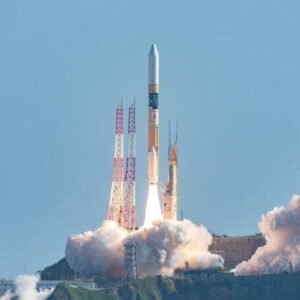
Why in news?
The Indian Prime Minister recently lay the groundwork for the Indian Space Research Organisation’s (ISRO) second rocket launchport in Kulasekarapattinam, Tamil Nadu.
What is the requirement for a new launch port?
- Capacity and Overburdening:
- Opening of the space sector to private players is expected to increase commercial launches significantly.
- This surge in demand could overwhelm existing launch facilities like the Satish Dhawan Space Centre (SDSC) SHAR in Sriharikota.
- Establishment of a new launch port ensures sufficient capacity to handle the increased number of launches without overburdening existing facilities.
- Diversification of Launch Services:
- By dedicating SDSC SHAR primarily for larger missions and creating the Kulasekarapattinam launchport for smaller payloads, ISRO can diversify its launch services.
- Specialization allows for more efficient utilization of resources and infrastructure tailored to specific mission requirements.
- Support for Private Players:
- The new launchport provides private players with dedicated infrastructure to develop space-qualified subsystems, build satellites, and launch vehicles.
- Encourages private investment and participation in the space sector, fostering innovation and competition.
Significance of Kulasekarapattinam Launchport:
- Geographical Advantage:
- Geographically, scientifically, and strategically, the Kulasekarapattinam launchport offers a natural advantage to ISRO’s future launches, particularly concerning the Small Satellite Launch Vehicle (SSLV).
- Its location allows for a direct southward trajectory, ideal for lightweight SSLVs carrying less fuel, thus enhancing ISRO’s payload capacities.
- Optimized Trajectory:
- Launches from Kulasekarapattinam can follow a straight southward flight path, unlike those from the Satish Dhawan Space Centre (SDSC) SHAR, which require skirting eastwards around Sri Lanka.
- This optimized trajectory minimizes fuel consumption, especially crucial for SSLVs with limited onboard fuel capacity.
- Equatorial Location:
- Similar to SDSC SHAR, Kulasekarapattinam is located near the equator.
- Equatorial launch sites benefit from Earth’s rotation, providing rockets with a significant velocity boost during liftoff.
- This boost in velocity allows for increased payload capacity, particularly advantageous for missions targeting geostationary orbit.
Is the Small Satellite Launch Vehicle (SSLV) Pioneering the Space Industry Revolution?
- Small Satellite Launch Vehicle (SSLV) is a launch vehicle consisting of three solid propulsion stages and a liquid propulsion-based Velocity Trimming Module (VTM) as a terminal stage.
- It is designed to launch 500kg satellites into a 500km planar orbit from the Satish Dhawan Space Centre (SDSC).
- Planar orbit, also known as low Earth orbit (LEO), is close to the Earth’s equatorial plane, ensuring a relatively flat path around the Earth.
- Key Features:
- Low Cost: SSLV offers cost-effective launch solutions.
- Low Turn-around Time: It ensures quick turnaround between launches.
- Flexibility: It can accommodate multiple satellites on a single launch.
- Launch Demand Feasibility: SSLV addresses the increasing demand for small satellite launches.
- Minimal Infrastructure Requirements: It requires minimal launch infrastructure.
- Significance:Era of Small Satellites:
- With the rise of small satellites, SSLV caters to the growing demand from various sectors such as businesses, government agencies, universities, and laboratories.
- Rise in Demand: The demand for small satellite launches has surged due to the growing need for space-based data, communication, surveillance, and commerce.
- Cost Savings: SSLV enables cost-effective and timely access to space, supporting the development of satellite constellations.
- Business Opportunity: The increasing demand for small satellite launches presents a lucrative business opportunity for space agencies like ISRO, especially for commercial satellite launches.
- Journey of SSLV:
- August 2022: SSLV-D1 mission encountered failure while attempting to deliver two satellites.
- February 2023: ISRO succeeded with SSLV-D2 mission, placing three satellites into a 450 km circular orbit after a 15-minute journey, both launches from SHAR.
What are the Features of SHAR?
- Geographical Location: Situated along the east coast of Andhra Pradesh, approximately 80 km off Chennai.
- Launch Infrastructure: Provides launch infrastructure for all ISRO missions.
- Facilities:
- Equipped with solid propellant processing setup, static testing, and launch vehicle integration facilities.
- Provides telemetry services, tracking, and command network to oversee the launch.
- Houses a mission control center.
- Launch Complexes:
- Consists of two launch complexes used for launching various ISRO vehicles:
- Polar Satellite Launch Vehicle (PSLV)
- Geosynchronous Space Launch Vehicle (GSLV)
- Geosynchronous Satellite Launch Vehicle Mk-III (LVM3)
- First Launch Pad:
- Maiden launch occurred in September 1993.
- Built in the early 1990s.
- Second Launch Pad:
- Operational since 2005.
- Maiden launch took place in May 2005.
People also ask
Q1: Where is Kulasekarapattinam launchport located?
Ans: Kulasekarapattinam launchport is situated along the east coast of Tamil Nadu, India, approximately 80 km off Chennai.
Q2: What are the advantages of its geographical location?
Ans: Geographically, Kulasekarapattinam launchport offers a natural advantage due to its direct southward trajectory, beneficial for launching lightweight SSLVs carrying less fuel.
Q3: How does its optimized trajectory differ from other launch facilities?
Ans: Launches from Kulasekarapattinam follow a straight southward flight path, minimizing fuel consumption compared to longer trajectories required by other facilities like SDSC SHAR.
Thanks for sharing. I read many of your blog posts, cool, your blog is very good.
Your point of view caught my eye and was very interesting. Thanks. I have a question for you.